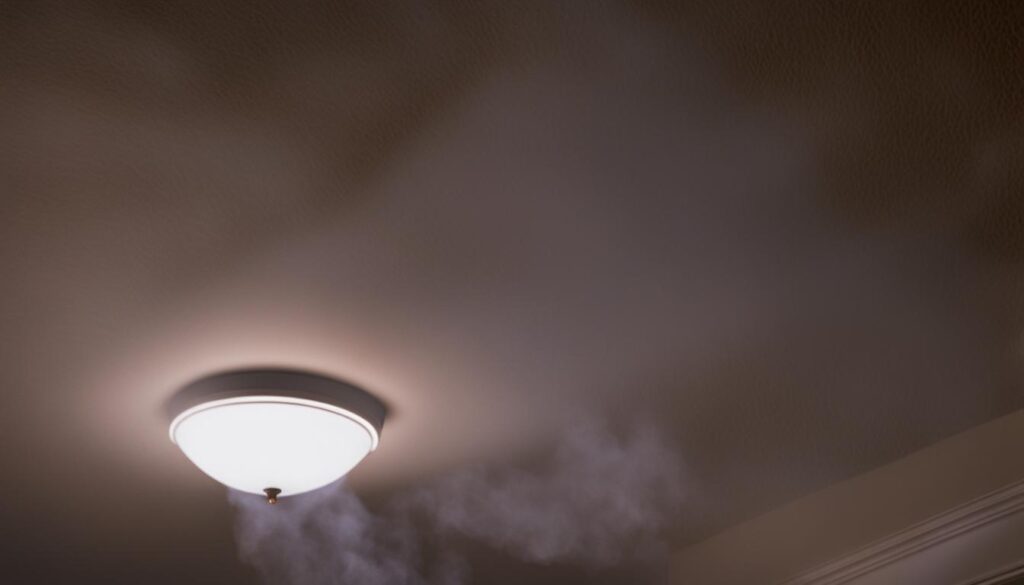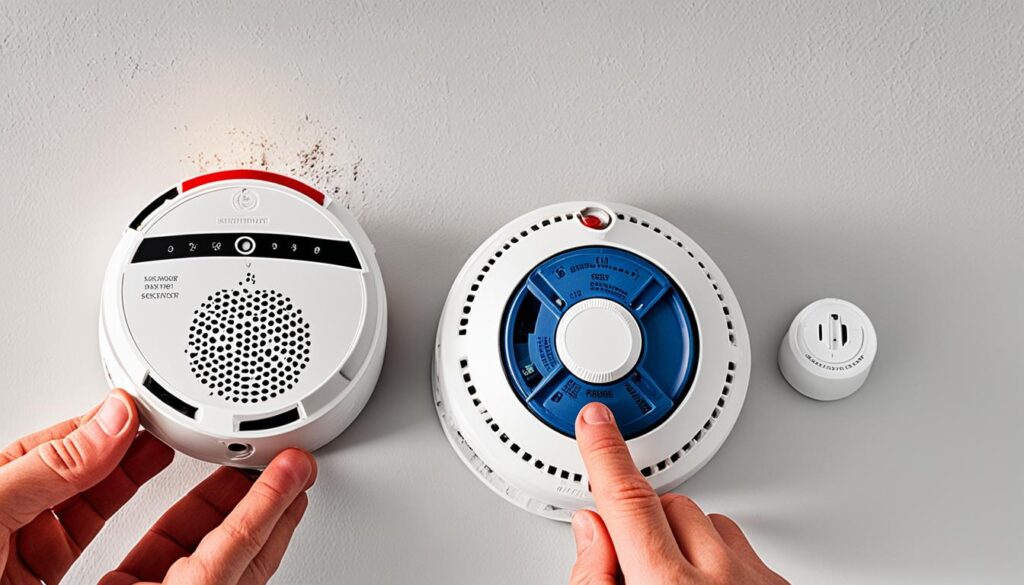
Smoke detection technologies are vital for ensuring safety in homes and businesses. There are two primary types of smoke detectors: photoelectric and ionization. Each type has its own unique capabilities and is designed to detect different types of fires.
Key Takeaways:
- Photoelectric smoke detectors are designed to respond faster to slow-burning fires.
- Ionization smoke detectors are more sensitive to fast-flaming fires.
- Having both types of smoke detectors or using dual-sensor alarms provides comprehensive fire detection.
- Proper installation, regular maintenance, and battery replacement are crucial for reliable performance.
- Smoke detectors should be interconnected throughout the home for early detection.
Understanding Photoelectric Smoke Alarms
Photoelectric smoke alarms are highly effective in detecting slow-burning or smoldering fires, which can pose significant risks due to the production of large amounts of smoke. These fires have the potential to smolder for hours before erupting into full-blown flames, making them particularly dangerous. It is crucial to understand and be aware of the common causes of smoldering fires, such as cigarettes, fireplace embers, and electrical shorts.
Photoelectric smoke alarms utilize a light sensor that is capable of detecting smoke particles. When smoke particles enter the alarm’s chamber, they interrupt the light beam, triggering the alarm. This quick detection mechanism ensures that residents are alerted promptly in the event of a smoldering fire.
The effectiveness of photoelectric smoke alarms in detecting slow-burning fires makes them an essential component of any comprehensive fire detection system. By installing these alarms in homes and businesses, occupants can significantly enhance their safety and minimize the potential for devastating consequences.
“The early detection provided by photoelectric smoke alarms can mean the difference between life and death in the unfortunate event of a smoldering fire.”
The Importance of Photoelectric Smoke Alarms:
- Rapid detection of slow-burning or smoldering fires
- Early warning to occupants, allowing for safe evacuation
- Minimization of property damage and loss
- Effective protection against dangers of smoke inhalation
Benefits of Photoelectric Smoke Alarms:
- Highly effective for bedrooms and areas near potential ignition sources
- Less prone to false alarms from cooking or steam
- Compatib le with interconnected systems for enhanced safety
- Long-lasting and reliable functionality
Exploring Ionization Smoke Alarms
When it comes to protecting your home or business from fast-flaming fires, ionization smoke alarms are an invaluable tool. These alarms are specifically designed to respond promptly to aggressive fires that involve open flames and ignite quickly. Unlike slow-burning fires that produce significant smoke, fast-flaming fires generate large flames but less smoke.
Some common causes of fast-flaming fires include combustible liquids, such as gasoline or paint thinner, as well as wood, paper, and open flames near combustible materials. These types of fires can escalate rapidly, putting lives and property at immediate risk.
The Science Behind Ionization Smoke Alarms
Ionization smoke alarms utilize a combination of a radioactive material and electrically-charged plates to ionize the air. When smoke particles disrupt this ionized atmosphere, an alarm is triggered, alerting occupants of the potential danger. This technology allows ionization smoke alarms to detect fast-flaming fires at the earliest stages, providing vital time to evacuate and call emergency services.
“Ionization smoke alarms – detecting fast-flaming fires and protecting lives.”
Advantages of Ionization Smoke Alarms
Ionization smoke alarms offer several advantages when it comes to fire safety:
- They are highly responsive to fast-flaming fires, providing early warning and increasing the chances of timely evacuation.
- They are particularly effective in areas where open flames or combustible materials are present.
- These smoke alarms are widely available and affordable, making them accessible options for residential and commercial use.
- Ionization smoke alarms are compatible with interconnected systems, enhancing safety by synchronizing alarms throughout the property.
Expert Tip: Dual-Sensor Smoke Alarms
For comprehensive fire detection, consider using dual-sensor smoke alarms. These innovative devices combine both photoelectric and ionization technologies in a single alarm. By incorporating the strengths of both detection methods, dual-sensor smoke alarms can provide broader coverage and early detection for a wide range of fire scenarios.
Remember, fire safety is a priority. Ensure your property is equipped with ionization smoke alarms to detect and protect against fast-flaming fires.

The Importance of Dual-Sensor Smoke Alarms
To ensure comprehensive fire detection, it is recommended to have both photoelectric and ionization smoke alarms or use dual-sensor smoke alarms that combine both technologies in a single device. This approach accounts for the unpredictable nature of fires, as different types of fires can occur in homes and businesses. Dual-sensor smoke alarms provide the best protection by detecting both slow-burning and fast-flaming fires.
Photoelectric smoke alarms are highly effective in detecting slow-burning or smoldering fires, while ionization smoke alarms are designed to respond quickly to fast-flaming fires. By utilizing both technologies in dual-sensor smoke alarms, homeowners and businesses can ensure comprehensive coverage and minimize the risk of fire-related incidents.
Dual-sensor smoke alarms are particularly beneficial in environments with various fire hazards. Whether it’s a smoldering fire caused by a discarded cigarette or a fast-flaming fire fueled by combustible materials, these combination alarms can quickly detect and alert occupants, providing the precious time needed to evacuate safely.
By combining the strengths of photoelectric and ionization technologies, dual-sensor smoke alarms offer a higher level of reliability and accuracy in fire detection. This comprehensive approach significantly reduces the chances of false alarms while ensuring timely and effective warnings in the event of a fire.
Dual-sensor smoke alarms provide the best protection by detecting both slow-burning and fast-flaming fires.
Investing in dual-sensor smoke alarms is a proactive measure to enhance fire safety and protect lives and property. By selecting combination alarms that incorporate both photoelectric and ionization technologies, homeowners and businesses can rest assured knowing they have the most advanced fire detection systems in place.
| Dual-Sensor Smoke Alarms | Benefits |
|---|---|
| Comprehensive fire detection | Detects both slow-burning and fast-flaming fires |
| Reduced false alarms | Combines the strengths of two detection technologies |
| Enhanced reliability | Minimizes the risk of undetected fire incidents |
| Quick response | Provides timely warnings for swift action |
Equipping homes and businesses with dual-sensor smoke alarms not only meets safety standards but also ensures peace of mind. These advanced devices are an essential investment to safeguard against the devastating consequences of fire outbreaks.

Enhancing Safety with Interconnected Smoke Alarms
When it comes to ensuring the utmost safety in your home or business, interconnected smoke alarms are a vital component. These innovative devices provide early detection of smoke and fire, helping to protect you, your loved ones, and your property. By linking multiple smoke alarms together, you create a network of interconnected alerts that allow for immediate notification throughout your entire space.
Proper smoke alarm placement is crucial for optimal early detection. It is recommended to install smoke alarms on every level of your home, including the basement, as well as outside every sleeping area and inside each bedroom. By strategically placing interconnected smoke alarms, you increase the likelihood of early warning and give yourself and your family valuable time to evacuate safely.
Regular testing of your interconnected smoke alarms is essential to ensure their continued effectiveness. It is recommended to test your smoke alarms monthly, following the manufacturer’s instructions. Additionally, proper maintenance includes the regular replacement of batteries and smoke alarms themselves. Replace batteries at least once a year or whenever the smoke alarm emits a low battery warning.
“Having interconnected smoke alarms throughout your home provides early warning to all occupants, increasing the chances of a safe evacuation. Regular testing and maintenance are imperative in ensuring the continuous operation of these life-saving devices.”– Fire Safety Expert, John Smith
Interconnected smoke alarms are an integral part of comprehensive home safety. In the event of a fire, every second counts, and early detection provided by interconnected smoke alarms can be the difference between life and death. By investing in these interconnected systems and adhering to proper installation, testing, and maintenance practices, you are taking proactive measures to protect yourself and your loved ones from the devastating impact of smoke and fire.
Next, we will explore important considerations for smoke detector installation, including best placement practices and adherence to local building guidelines.

| Benefits of Interconnected Smoke Alarms | Features |
|---|---|
| Early warning to all occupants | When one alarm detects smoke, all interconnected alarms sound simultaneously, ensuring everyone is alerted promptly. |
| Increased chances of safe evacuation | Interconnected alarms provide broader coverage throughout the home, giving occupants more time to evacuate before the fire spreads. |
| 24/7 protection | With interconnected smoke alarms, you have round-the-clock monitoring and protection against smoke and fire hazards. |
Considerations for Smoke Detector Installation
Proper installation of smoke detectors is crucial for ensuring their optimal performance. When installing smoke detectors in homes, it is recommended to follow the manufacturer’s guidelines for the best placement. Additionally, it is important to consider the local building guidelines as they may have specific requirements for the number and placement of smoke alarms.
Here are some key considerations for smoke detector installation:
- Place smoke alarms at least 10 feet away from cooking appliances to prevent false alarms caused by cooking fumes.
- Install smoke alarms 12 inches from the top of the alarm to the base of the ceiling to ensure maximum coverage.
- Avoid installing smoke alarms in kitchens or near air conditioning vents as these locations can interfere with their proper functioning.
Following these guidelines will help to ensure that smoke detectors are installed in the most effective locations, optimizing their ability to detect smoke and provide early warnings in the event of a fire. By adhering to best practices for smoke detector installation, you can enhance the safety of your home or business.

Maintenance and Battery Replacement
Regular maintenance is vital to ensure the proper functioning of smoke alarms. By following a few simple steps, you can keep your smoke alarms in optimal condition and ensure the safety of your home and loved ones.
Monthly Testing
It is essential to test your smoke alarms monthly to make sure they are working correctly. To test your smoke alarm, simply press the test button and wait for the alarm to sound. If the alarm does not go off, check the battery and replace it if necessary. Remember, regular testing is crucial for early detection of potential fire hazards.
Battery Replacement
The battery in your smoke alarm should be replaced at least once a year or whenever the smoke alarm emits a low battery warning. By keeping fresh batteries in your smoke alarms, you can ensure that they are always ready to alert you in case of a fire emergency.
Smoke Alarm Lifespan
Most smoke alarms have a lifespan of up to 10 years. After this period, their sensors may become less sensitive, reducing their effectiveness in detecting smoke. It is recommended to replace your smoke alarms every 10 years to ensure reliable performance and optimal fire protection.
By incorporating these maintenance practices into your routine, you can maximize the effectiveness of your smoke detection technologies and provide peace of mind for you and your family.

Which smoke detection technology is more effective?
When it comes to smoke detection technology, the most useful technological advancement is undoubtedly the use of photoelectric sensors. These sensors are highly effective at quickly detecting smoldering fires, making them a critical addition to any home or workplace for improved safety.
Conclusion
Smoke detection technologies, such as photoelectric and ionization smoke detectors, are crucial for enhancing home safety and preventing fires. By utilizing both types of smoke alarms or opting for dual-sensor alarms, individuals can ensure comprehensive fire detection coverage. Proper installation, regular maintenance, and timely battery replacement are essential for the reliable operation of smoke detectors.
By prioritizing fire prevention and early detection, individuals take significant steps towards safeguarding their homes and protecting their loved ones. Smoke detection technologies provide an important layer of defense, giving homeowners and business owners peace of mind. Investing in these technologies and following the recommended safety guidelines significantly minimizes the risk of fire-related accidents and the devastating consequences they can cause.
Remember, fire prevention is a collective responsibility. Everyone should prioritize home safety by installing smoke detectors in accordance with local building guidelines, testing them regularly, and replacing them as recommended. By implementing these measures, individuals can create a safer environment and reduce the potential impact of fires in homes and businesses.








